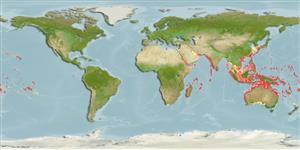Common names from other countries
Environment: milieu / climate zone / depth range / distribution range
Οικολογία
Θαλασσινό(ά) Υφαλόφιλο(α); μη μεταναστευτικό(ά); εύρος βάθους 0 - 60 m (Ref. 89972). Tropical; 30°N - 20°S
Indo-Pacific: Red Sea and East Africa (extending to Mossel Bay, South Africa, Ref. 5372) to the Hawaiian, Marquesan, and Ducie islands, north to southern Japan, south to Lord Howe and Rapa islands.
Length at first maturity / Μέγεθος / Βάρος / Age
Maturity: Lm 13.0 range ? - ? cm
Max length : 25.0 cm TL αρσενικό/απροσδιόριστο; (Ref. 129178)
Ραχιαίες άκανθες (συνολικά) : 12 - 13; Μαλακές ραχιαίες ακτίνες (συνολικά) : 22 - 25; Εδρικές άκανθες: 3; Μαλακές εδρικές ακτίνες: 19 - 21.
May be seen in a variety of habitats ranging from rich coral reefs (Ref. 58652) to weedy and rubble covered areas (Ref. 1602). Benthopelagic (Ref. 58302). Maybe found singly, in pairs, and in aggregations that roam over large distances in search of food. Feed mainly by tearing pieces from polychaetes, sea anemones, coral polyps, and algae (Ref. 1602). Oviparous (Ref. 205). Form pairs during breeding (Ref. 205). Minimum depth reported taken from Ref. 128797.
Life cycle and mating behavior
Maturities | Αναπαραγωγή | Spawnings | Egg(s) | Fecundities | Προνύμφες
Distinct pairing (Ref. 205). Monogamous mating is observed as both obligate and social (Ref. 52884).
Allen, G.R., 1985. Butterfly and angelfishes of the world. Vol. 2. 3rd edit. in English. Mergus Publishers, Melle, Germany. (Ref. 4858)
IUCN Red List Status (Ref. 130435)
CITES (Ref. 128078)
Not Evaluated
Threat to humans
Reports of ciguatera poisoning (Ref. 130160)
Human uses
Can't connect to MySQL database (fbapp). Errorcode: Too many connections
